I make jajangmyeon any time I’m craving Korean noodles, but don’t have a lot of extra time to devote to cooking. My vegan version comes together with a simple but potent mix of chunjang (black bean paste) and veggies that add a pliant crunch. It never takes me more than 30 minutes to make – and my taste buds are always thankful!

The first time I tried Korean jajangmyeon, I was actually in Japan – visiting close friends in Yokohama. They took me to a Korean BBQ spot and started ordering bulgogi and dolsot bibimbap before we even cracked the menus open. But the watershed moment came as I sunk my metal chopsticks into a plate of jajangmyeon (짜장면). The chewy wheat flour noodles were practically lacquered in a dark and glossy, savory, thick black bean sauce that was so full of umami it took a moment for my taste buds to process what was actually happening.
And that precise moment of noodle bliss is why I dedicated myself to creating a plant based jajangmyeon that did away with the traditional pork belly – without sacrificing the salty, sweet smokiness. Turns out, it wasn’t that difficult. Fermented Korean black bean paste (chunjang) does the heavy lifting – and has many overlapping savory, caramel and earthy flavors. Plus, my mix of button mushrooms and zucchini delivers a texture that comes across wholeheartedly meaty.
Table of Contents
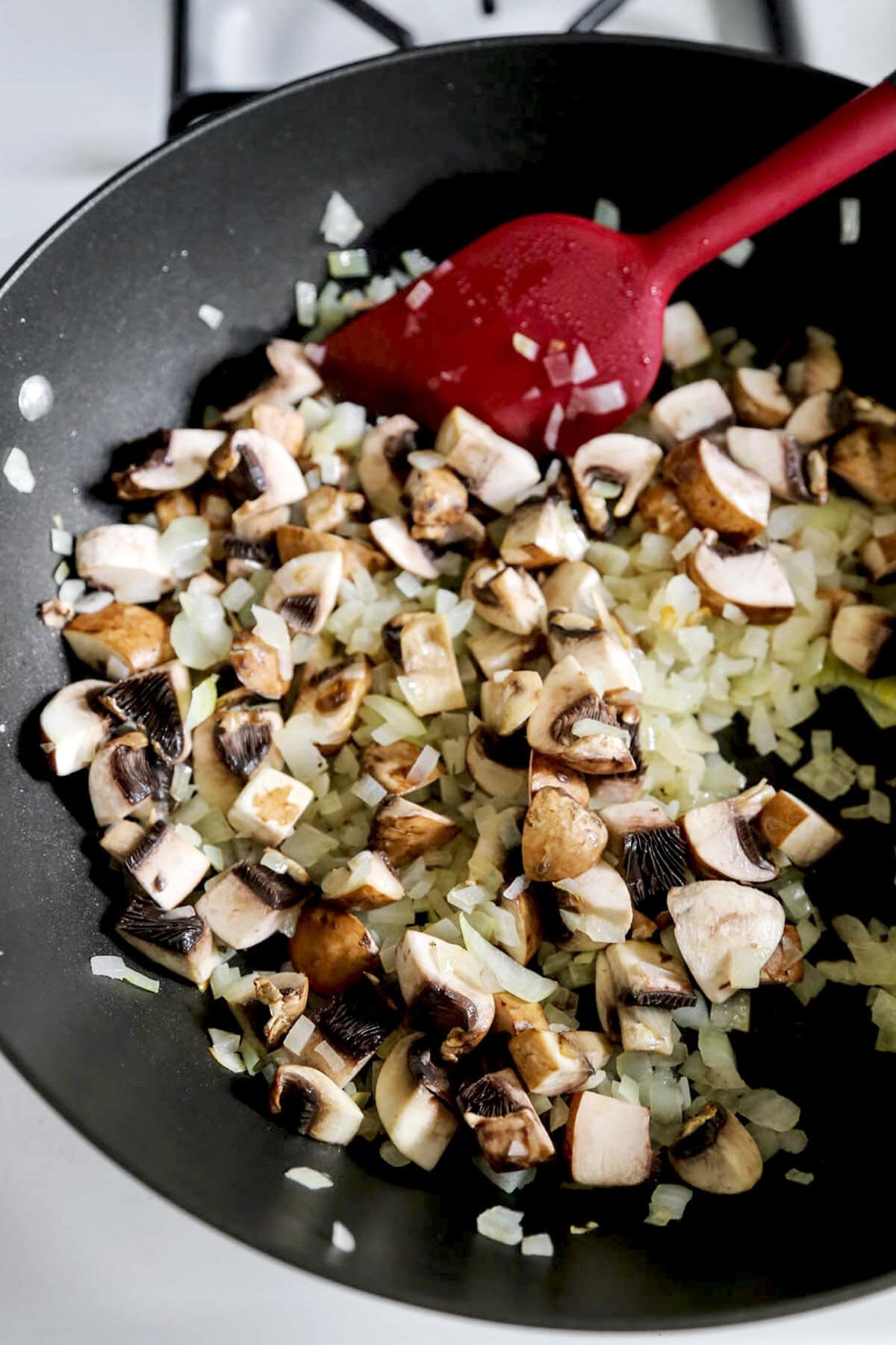
Why I Love This
Honestly, I was a little concerned about making jajangmyeon without pork belly. It seemed essential to the dish. But I’ve laid off eating meat for years now. This was one of my first moments as a home chef that taught me to play with flavors and textures to make a vegan meal that still fully honors the original. Since then, I’ve made vegan dan dan noodles and a plant based gyudon that smacks. But jajangmyeon was one of my firsts in this realm. It’s as savory and satisfying as the original – and I’m proud of it.
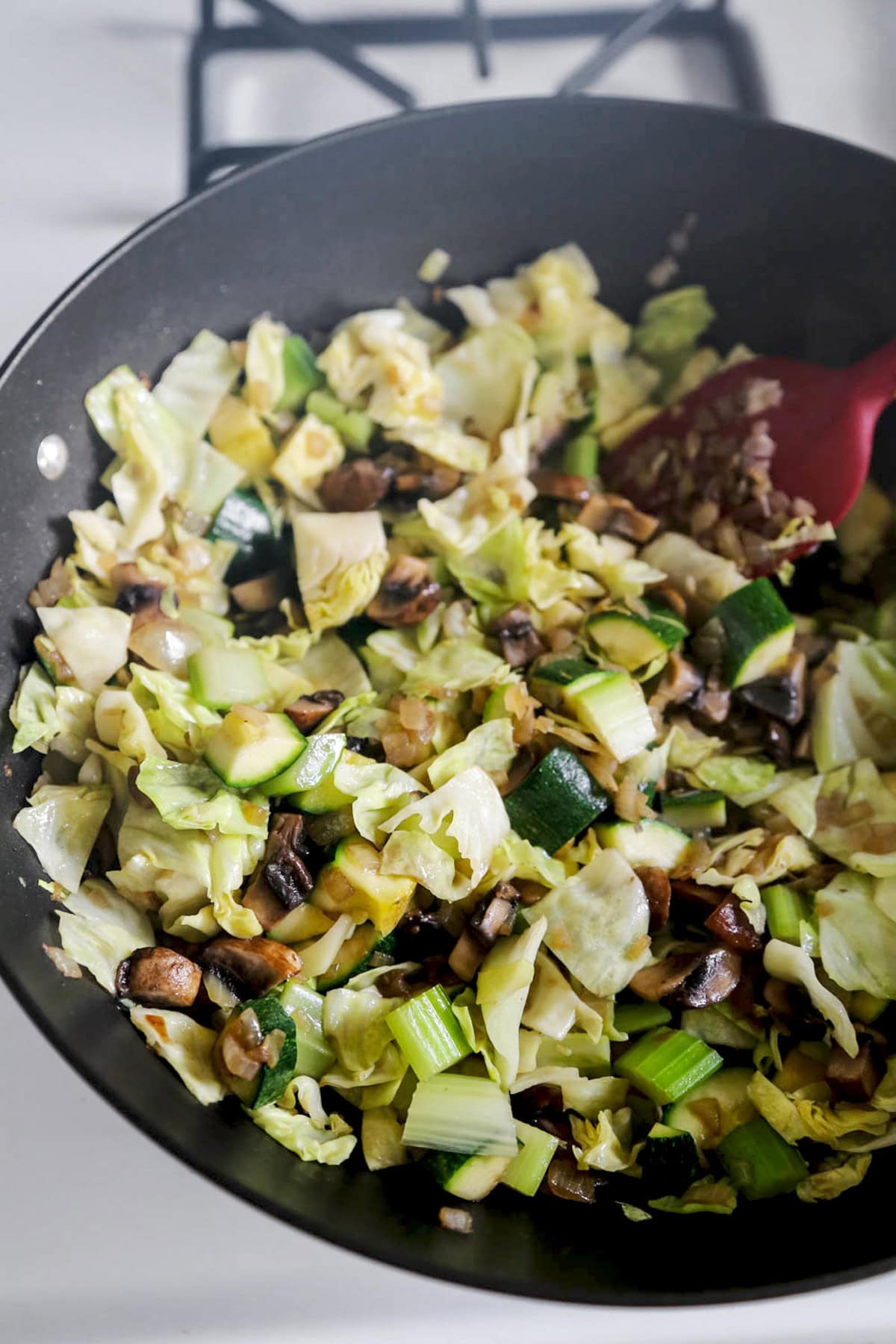
Ingredients
Scroll to the bottom of this page for the full recipe steps and measurements.
- Udon Noodles: Both dry and fresh noodles work. Udon is made from wheat flour (so not gluten free). I love the chewy and springy texture.
- Cooking Oil: I use any neutral cooking oil I have handy. Vegetable and grapeseed oil are my usual suspects.
- Onion: One medium onion, chopped finely.
- Button Mushrooms: I quarter button mushrooms and quickly sauté these.
- Zucchini, Celery and Cabbage: All chopped bite sized. I cook this medley of veggies until tender-crunchy. Trust me, this combination does wonders in the texture department.
- Cucumber: I slice these into matchsticks and use as a fresh garnish. Works best with Korean and English cucumbers (super crunchy with small seeds).
Sauce Ingredients
- Korean Black Bean Paste (Chunjang): Looks like thick squid ink. But chungjang is made from fermented black soy beans instead. Salty, sweet and earthy. I use 6 tablespoons in this recipe.
- Rice Vinegar: Rice vinegar has a mild sweetness and is less overtly tart than white vinegar.
- Brown Sugar
- Starch Slurry: A slurry is just a combination of potato starch (or cornstarch) and water. I mix it and stir it in near the end to thicken my jajangmyeon sauce.
- Salt and Pepper: To taste.
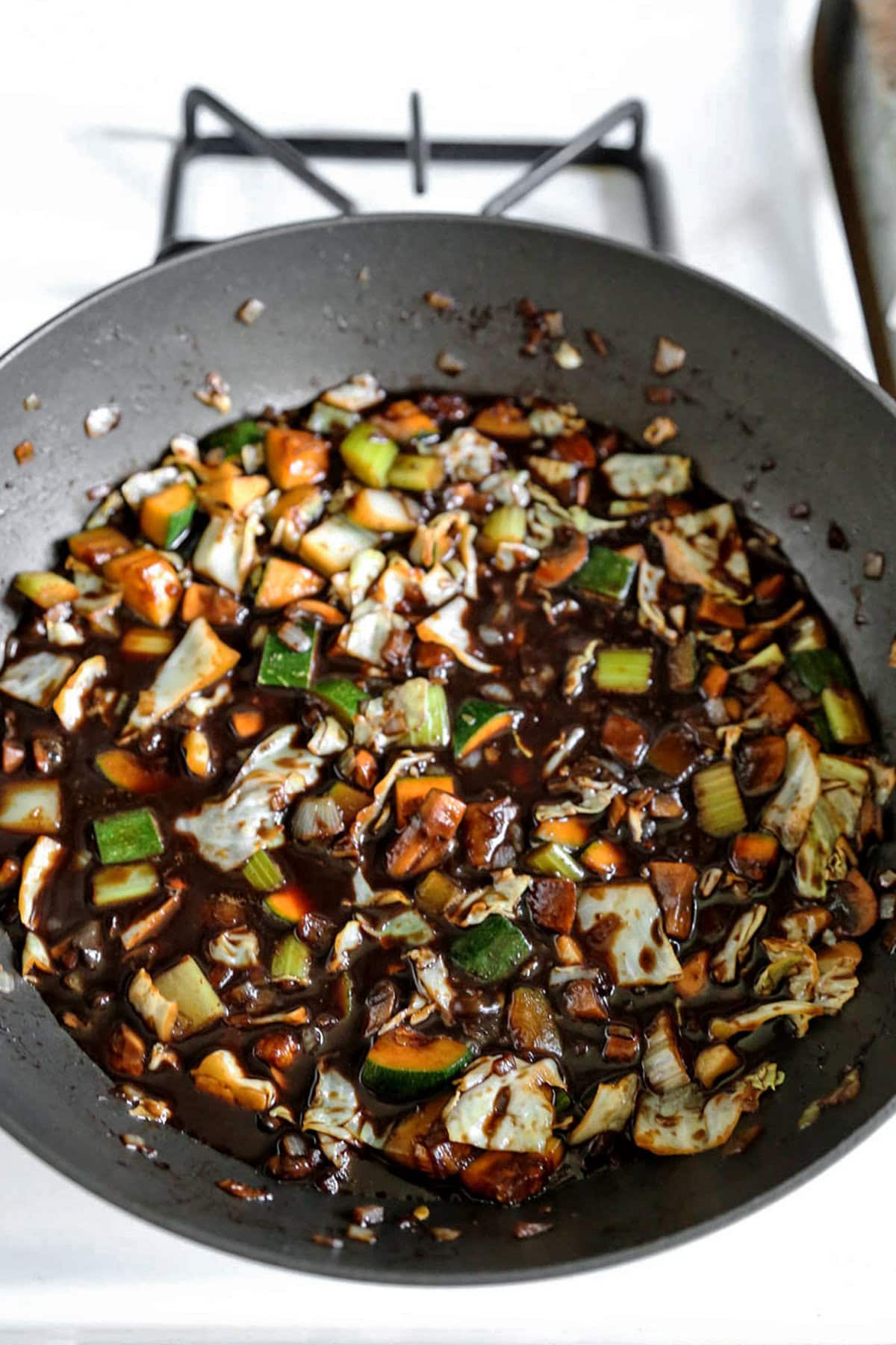
How to Make It
- Cook the vegetables. Start with the onion and sauté until fragrant and translucent. Then add the sliced mushrooms, zucchini, celery and cabbage.
- Mix in the sauce ingredients. Thoroughly mix, cover and simmer for 10 minutes.
- Thicken the sauce. Slowly add the cornstarch slurry to the sauce (stirring constantly) and stir until the sauce thickens.
- Boil the noodles. Follow the timing instructions on the udon package. Drain and rinse under cool water.
- Mix, garnish and serve. Combine the cooked noodles with sauce. Garnish with sliced cucumber.
Expert Tip
Mix the slurry well before adding it to the sauce. Cornstarch (or potato starch) mixes fairly easily with cold water. However, it quickly separates into a layers of water and concrete if left on the counter for any amount of time. To combat this, I just make sure to re-mix it before adding it to my sauce.
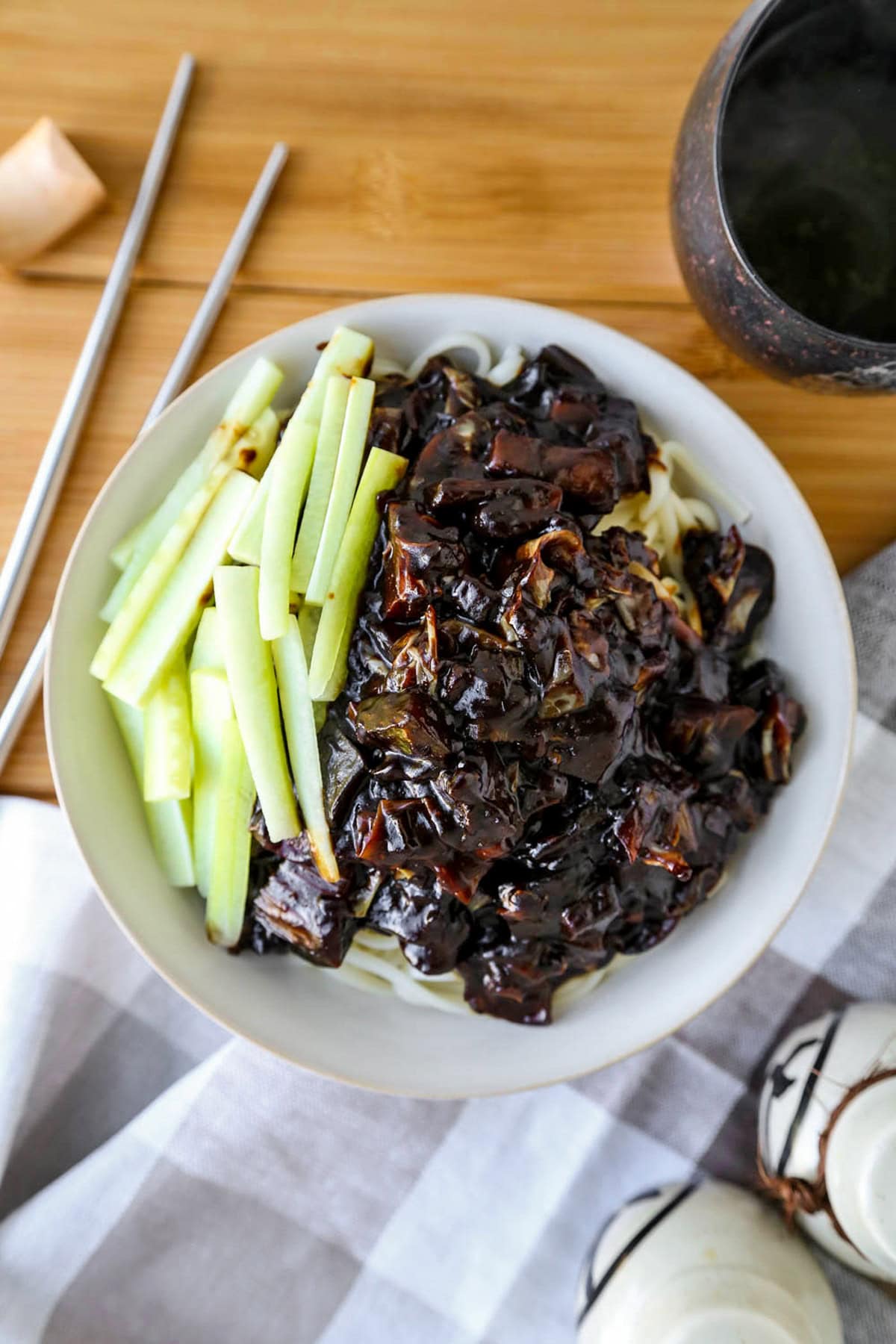
Recipe Variations
If cooking at home has taught me anything, it’s not to get too hung up on recipes. Sometimes, I have to use what I have handy in the pantry. And sometimes, I know something will taste better if I use my better judgement. Here are a few suggestions when making jajangmyeon.
- Use different noodles. I love udon, but never get hung up when I’m running low. I’ve made jajangmyeon with everything from Chinese egg noodles to a fried brick of noodles I salvaged from a pack of instant ramen.
- Switch the vegetables. Use whatever’s fresh and handy in the crisper.
- Add a protein. Vegans can use sliced smoked tofu or soy strips.
- Use meat. The Korean original calls for pork belly.
- Use different garnishes. I like cucumbers or sliced daikon radish – but finely chopped green onions would work as well.

Storage and Make Ahead Options
Store leftover jajangmyeon in the refrigerator (covered) for up to 2 days.
I often prep this meal by making the black bean sauce – and chopping my veggies – ahead of time so all I have to do is boil the noodles for a quick dinner.
As long as it hasn’t already been mixed with the noodles, the black bean sauce will keep refrigerated for up to 5 days.
What to Serve With Jajangmyeon
I could make an entire meal out of Korean banchan. That’s the small army of side dishes served alongside the main courses at Korean BBQ joints. Here are a few of my favorite banchan that go super well with these noodles.
- Spicy Daikon Radish Salad (무생채)
- Steamed Korean Eggplant (Gaji Namul)
- The Best Vegan Kimchi – 김치
- Korean Cucumber Salad (Oi Muchim)
- Korean Bean Sprout Salad (Sookju Namul)
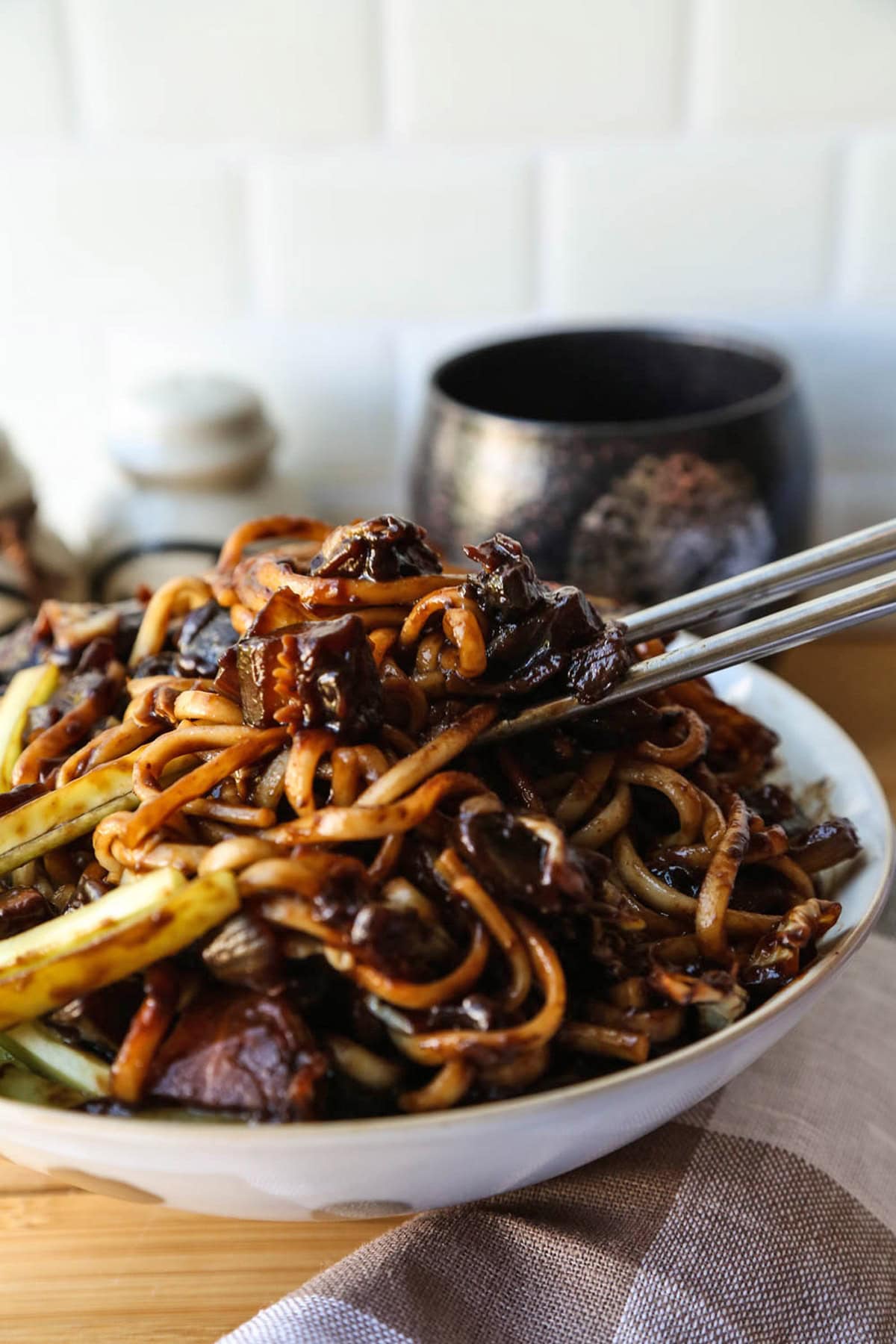
Frequently Asked Questions
It’s available at many Asian grocery stores – or you can pick up chunjang online.
Garden cucumbers are loaded with a strip of massive, watery seeds running through the center. If you use garden cucumbers, be sure to scoop out those seeds prior to slicing them. A better alternative is to use English cucumbers that have a crisp crunch and smaller seeds.
If the udon noodles are mushy, they’re probably overcooked. Like with all pasta, udon will continue to cook after it has been drained. So after draining it, I like to either run it under cold tap water – or plunge it into an ice bath (water and ice) to stop the cooking process.
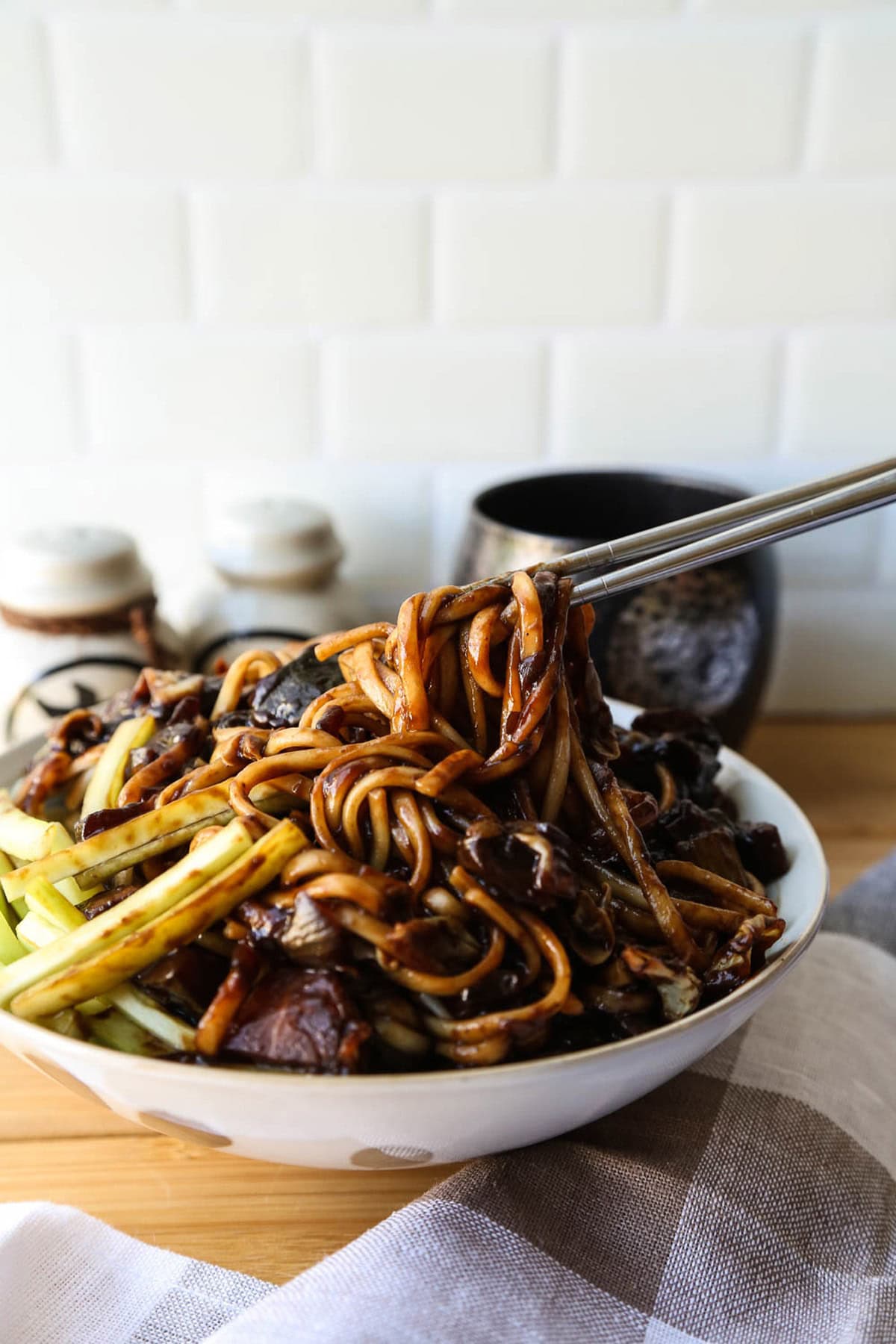
Did you like this recipe? Are there changes you made that you would like to share? Share your tips and recommendations in the comments section below!
Print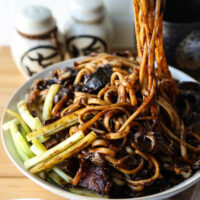
Jajangmyeon (Korean Noodles With Black Bean Sauce)
- Prep Time: 10 minutes
- Cook Time: 20 minutes
- Total Time: 30 minutes
- Yield: 4 people 1x
- Category: Noodles
- Method: Pan frying
- Cuisine: Korean
- Diet: Vegan
Description
Traditional Korean noodles made with black bean paste and veggies. My Jajangmyeon recipe is ready in just 30 mins!
Ingredients
- 8 ounces dry udon noodles (or 12 ounces fresh udon or Chinese noodles)
- 1 tablespoon vegetable oil
- 1 medium onion, finely chopped
- 8 ounces button mushrooms, quartered
- 1 zucchini, chopped bite size
- 2 celery stalks, chopped bite size
- 7 ounces cabbage, chopped bite size
- 1/2 cup cucumber, peeled and sliced into matchsticks
For the sauce
- 6 tablespoons Korean black bean paste
- 2 1/2 tablespoons rice vinegar
- 2 tablespoons brown sugar
- 1 cup water
- 2 tablespoons potato starch mixed with 1/4 cup water
- salt and pepper, to taste
Instructions
- Cook the onions. In a large deep pan over medium high heat, add oil and onions. Cook for a couple of minutes until onions are translucent.
- Add mushrooms. Cook for 5 minutes, or until the water coming from the mushrooms has evaporated.
- Add zucchini, celery and cabbage. Stir well. Cook for 3-4 minutes, until vegetables are half cooked.
- Season. Add Korean black bean paste, rice vinegar and sugar and stir until sugar has dissolved. Lower the heat to medium and add water. Stir well, cover and cook for 10 minutes.
- Add the starch slurry. Whisk the potato starch mixture into the sauce and stir until it thickens. Turn the heat off and set aside.
- Boil the noodles. Bring a pot of water to boil, and cook the noodles according to package instructions. Rinse under cold water and drain well. Transfer to a serving bowl.
- Mix and serve. Top with sauce and sliced cucumber. Serve hot or at room temp.
Notes
I often prep this meal by making the black bean sauce ahead of time so all I have to do is boil the noodles for a quick dinner. The black bean sauce will keep refrigerated for up to 5 days. Once mixed, leftover jajangmyeon should be eaten within 2 days.
Nutrition
- Serving Size: 1 serving
- Calories: 263
- Sugar: 9.4g
- Sodium: 1248mg
- Fat: 4.4g
- Saturated Fat: 2.1g
- Unsaturated Fat: 0.5g
- Trans Fat: 0g
- Carbohydrates: 14.5g
- Fiber: 2.5g
- Protein: 3.2g
- Cholesterol: 1.8mg
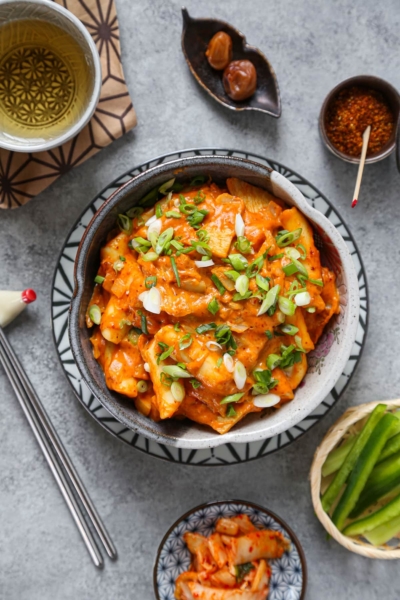

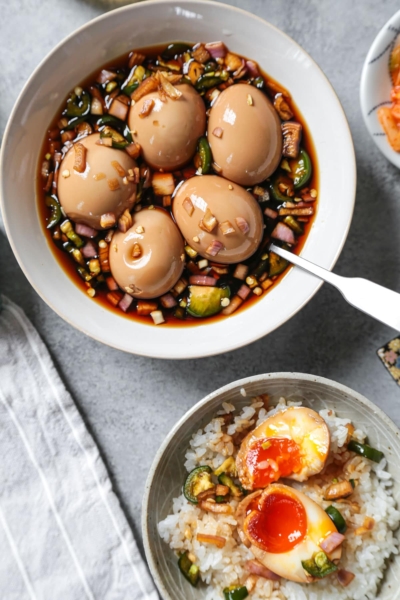
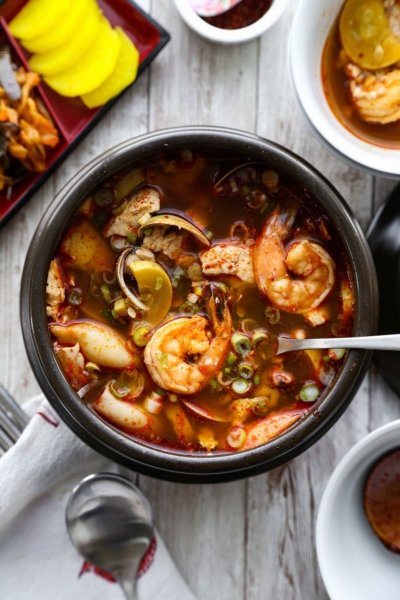















Questions and Reviews
This recipe was so good! Thank you!!
Excited to try this recipe! I’m having trouble locating udon noodles at the moment. Would ramen or rice noodles work?
Hi Shira! I think that a thicker rice noodle might work well with this 🙂 . I’m afraid ramen noodles might be too thin since the sauce is quite thick.
Love this recipe! I doubled it and kept half in the freezer for future quick meals!
What brand of chunjang did you use?
Thank you Randy! I use the Haechandeul brand and another that I cannot translate unfortunately (I don’t read Korean) 🙁
What is the 3 cups of water for in the sauce ingredients? Do I add that to the sauce or is that to boil the noodles? I don’t see where to add it in the directions. Thank you!
Oh wait! Just saw it! Thanks!
Hey! Can I use the Lee Kum kee spicy black bean sauce instead?
Hi Maureen! I’m sure you can although I’ve never done it. Since Lee Kum Kee’s spicy black bean sauce is quite salty, make sure you water it down.That would be my only advice since this dish is pretty mild 🙂
Delicious! I did 5 tablespoons of black bean paste instead of 6 as it was already very flavorful. For extra protein, do you think we can add tofu or would it taste weird? Or do you have any other recommendations? Thanks!
Hi Ivory! I think tofu is a great idea for extra protein. You could also try steamed broccoli (which is higher in protein than steak) or a handful of spinach, which I think would be yummy 🙂
hi! can i substitute the korean bean paste for miso? Do you think the taste would be too different ?
Hi Amanda! The taste would be very different with miso paste. Korean black bean paste is quite mild in taste compared to miso paste. You could use Chinese black bean sauce, that would be much closer to the taste (but still different of course 🙂 )
Thanks for this very easy recipe! I’ve made it twice and it comes out delicious both times, really enjoy it.
O M G this is really good, this is my first time trying black bean noodles and this didn’t disappoint
Yummo, always loved this but am now WFPB vegan so minor adjustments made and wallllaaa. Soooo good thank you for the recipe
Thank you Sue! 🙂
Made this a few times at home now and last night for a dinner party. It was the star of the show!! (that and the Korean BBQ but then who doesn’t like a Korean BBQ?!?!?)
This really was loved by everyone! This Jajangmyeon is absolutely delicious!! Everyone has asked for the recipe and they spent some of the evening buying Korean ingredients online. I do love to spread the Korean love! haha
Thank you Vanessa! Nothing wrong with spreading the Korean love lol!
My udon noodles always stick toghether as a big lump. What do I do wrong?
Hi LittlFrenchy! When you boil the noodles it’s good to stir them often with chopsticks to make sure they boil separately. If they stick together after they are cooked, they might be overcooked or it could just be the brand that you purchase (there are some badly made noodles out there!). I suggest buying them from a Japanese grocery store. What also helps is to add just a drizzle of oil to your noodles and quickly toss them right after you drain them.
Can i use corn starch instead of potato starch?
Yes Rose, that’s totally fine 🙂